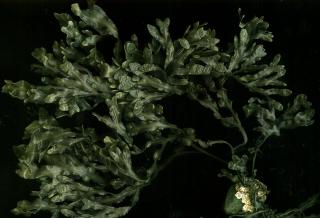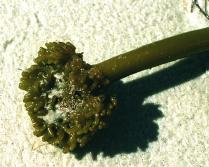







Phaeophytes are the largest of the chromists, and are among the largest photosynthetic organisms on earth. The largest kelps may grow to more than 60 meters in length, forming dense underwater forests. Though the giant forms receive more notice, there are also many microscopic brown algae. These may grow as epiphytes on underwater vegetation, forming networks of branched filaments, or broad encrustations.
Among all this variation, there are no unicellular or colonial phaeophytes -- all are multicellular, and have a large surface area. They depend on this to acquire dissolved nutrients from the surrounding water, in much the same way that animals use the large surface area of their gills in order to obtain oxygen.
New tissues are added by a variety of processes, each involving cell division within a relatively localized part of the body. Some have parenchymatous growth, in which divisions of cells may occur in multiple directions. This kind of growth produces broad sheets of tissues, or thick regions. Most kelps renew their damaged tissues through intercalary growth, in which the cell divisions occur in the middle of a set of tissues, usually near the base of the stalk. This is in contrast to the apical growth in plants, which among phaeophytes is found only in a few dreived forms of Fucales and Dictyotales.

 Many large kelps use gas-filled floatation bladders to keep their large
blades near the surface, and therefore in the light. The bladders are filled
with respired gases, some of which would be considered toxic by humans. A
very few large kelps have pitted walls, that is, there are are openings
between neighboring cells which will allow dissolved substances to pass
freely between thses cells. This is structurally quite similar to the phloem
found in vascular plants, but is likely a
product of convergent evolution. Kelps have no definite fossil record before
the Miocene, and the trait has been found in only three genera of the single
family Lessoniaceae.
Many large kelps use gas-filled floatation bladders to keep their large
blades near the surface, and therefore in the light. The bladders are filled
with respired gases, some of which would be considered toxic by humans. A
very few large kelps have pitted walls, that is, there are are openings
between neighboring cells which will allow dissolved substances to pass
freely between thses cells. This is structurally quite similar to the phloem
found in vascular plants, but is likely a
product of convergent evolution. Kelps have no definite fossil record before
the Miocene, and the trait has been found in only three genera of the single
family Lessoniaceae.
Phaeophytes have a number of compounds which help them to retain water. This might seem unneccessary for an alga, since it is immersed in water, but many brown algae live in the intertidal zone, where they may become exposed to the air at low tide. Alginic acid, along with cellulose, is a component of phaeophyte cell walls. This polysaccharide is a viscous gel which absorbs and retains water. Consider how slowly gelatin evaporates and you get a feel for how alginic acid works.


